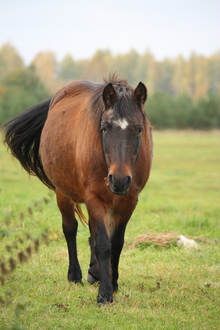On Tuesday, March 25, 2014, speakers Paul D. Siciliano, PhD | North Carolina State University and Shannon Pratt Phillips, PhD of Carolina State University will present a webcast: Pasture Associated Laminitis Prevention Strategies at at 7:00 EST as part of Michigan State's My Horse University's eXtension services.

Pasture consumption and its effects on horses
In this webinar the relationship between pasture consumption, horse-type and laminitis will be discussed in the context of strategies aimed at preventing pasture-associated laminitis.
Laminitis Presentation Summary:
Excess pasture consumption is often cited as a factor associated with the precipitation of laminitis, a devastating disease affecting horses feet. However the relationship between pasture consumption and laminitis does not appear to be similar among all horses, i.e. some horses appear to be more at risk for developing laminitis while grazing pasture than others. In this webinar the relationship between pasture consumption, horse-type and laminitis will be discussed in the context of strategies aimed at preventing pasture-associated laminitis.
Overview
Laminitis, a metabolic disorder commonly referred to as founder, can affect all four feet, but is most common in the front feet. Laminitis causes the sensitive and insensitive lamina of the hoof wall to become inflamed, leading to separation. The lamina provides support to the coffin bone.
When separation occurs, typically the coffin bone rotates downward. As the coffin bone rotates downward, it presses the sole of the hoof, causing severe lameness. In severe cases, the tip of the coffin bone can penetrate the sole of the hoof. A less common occurrence is total separation of the lamina supporting the coffin bone and the entire coffin bone will sink within the hoof capsule.
Presenter Information: Paul Siciliano is Professor in the Department of Animal Science at North Carolina State University where he teaches courses in equine management and conducts research in equine nutrition. Siciliano received a B.S. (1987) from The Ohio State University and an M.S. (1992) and Ph.D. (1996), both from the University of Kentucky. He was previously a faculty member in the Department of Animal Science at Colorado State University from 1996 to 2006. Siciliano has been a member of the Board of Directors (2000-2005), Secretary/Treasurer (2005-2007), Vice President (2007-2009), and President (2009-2011) for the Equine Science Society. He also served as a member of the National Research Council Committee on Nutrient Requirements of Horses (2004-2007).
Shannon E. Pratt Phillips is an Associate Professor in the Department of Animal Science at North Carolina State University. She teaches in the field of general equine science and equine nutrition, both via traditional face-to-face classes and online. She conducts research in the field of glucose metabolism, insulin resistance and obesity in horses. Pratt Phillips received her B.S. (1997) from the University of Guelph, her M.S. (1999) from the University of Kentucky and her Ph.D. (2005) from the University of Guelph. She is a member of the Equine Science Society, North American Colleges and Teachers of Agriculture, American Society of Animal Science and the American Registry of Professional Animal Scientists, and she is the Past-President of the American Academy of Veterinary Nutrition.
Register for the webcast
